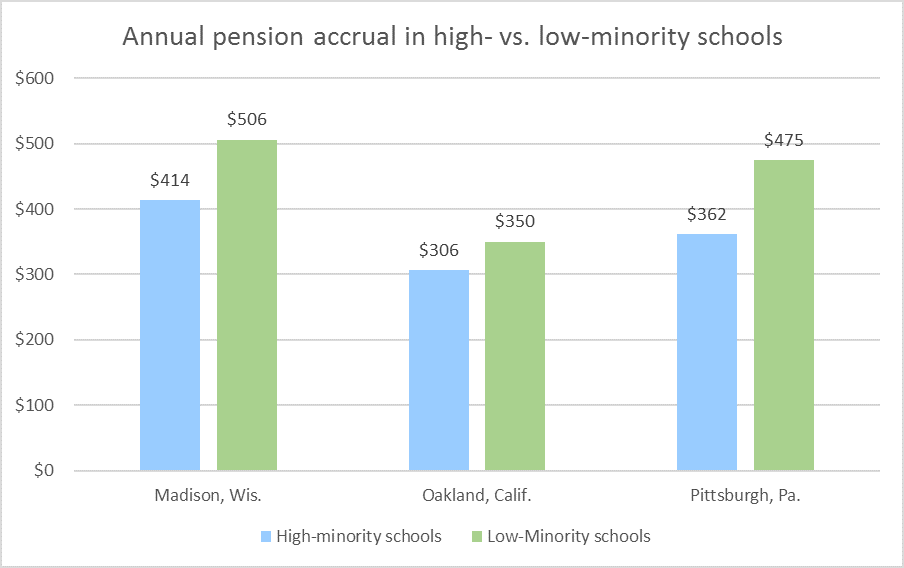Each year, about $30 billion in U.S. public funds goes toward teacher pensions, representing roughly 5 percent of all K-12 education spending nationally. (Analysis also indicates that the total funds committed are even larger given that current pension systems are underfunded to the tune of $325 billion.) These funds are an important component of teacher compensation, particularly where teachers make a tradeoff, accepting lower salaries in anticipation of realizing pension benefits at the end of their career. Given the sheer magnitude of this expenditure, my team at Edunomics Lab wondered: How equitably are these public pension funds applied across schools?
We already know a lot about spending inequities created by uneven teacher salaries: Longevity-based pay drives more public dollars to schools with more senior teachers (often schools that serve a smaller share of poor and minority students than other schools in a given district), thereby shortchanging some of the highest needs students. The U.S. Education Department’s Office for Civil Rights has flagged these patterns of “disparate impact” as problematic. But the growing body of analysis around teacher pensions hasn’t focused on the equity question—until now.
In “The Equity Problem in Teacher Pensions,” released in January, we take a preliminary look at the scope of variation in how pension funds are applied across schools in order to shed light on meaningful patterns that have largely remained in the dark. Our initial analysis of patterns in Delaware and three districts in Wisconsin, California, and Pennsylvania suggests that the current pension wealth accrual structure results in an inequitable deployment of these key education resources.
Pension accrual is lower in high-minority schools
We started our analysis in Delaware, where we examined the portion of teachers at each elementary school who are “vested” in the pension system (and had accrued any pension wealth). Not surprisingly, a smaller share of the teachers in the high-minority quartile of schools were vested (see below). Since high-minority schools have a smaller portion of vested teachers, their faculties are, on average, reaping a smaller portion of the state’s education funding pie via pensions. In other words, Delaware pension spending disproportionately benefits teachers in low-minority schools.
We then used more detailed teacher-level datasets from another three districts that included age, salary, and years of service to compute the incremental pension wealth accrual per teacher (less employee contributions). These details allow us to see which specific teachers earn pension benefits in what amounts. We summed those changes in pension wealth accrual across schools, and divided the sum among students they served.

In all three districts, high-minority schools draw less in publicly funded pension wealth among their teachers than low-minority schools. The differences in pension accrual between high- and low-minority schools ranged from about $40 to $110 per student. While those dollar differences may seem negligible (less than 1 percent of the average per pupil expenditure in each district), the patterns were decidedly not random.
Does this matter?
The billions of public funds used for teacher pensions nationwide must be considered part of the total funding pot available for educating students. But, typically, pension monies aren’t thought of or treated that way. The status quo practice of keeping pension payments and liabilities off annual school-level spending works to divorce pension spending from the intended beneficiaries of any and all public education spending—the students. Part of the challenge is that in some states, teachers are lumped together with other state employees into one larger, centrally administered public employee pension system with little separation by sector in budgeting or accounting.
With so many public education dollars working in service of teacher pensions, the issue of equity applies to pensions just as it does to any other kind of public education spending. Policymakers, politicians, and the public must ask whether tying up such a significant portion of public monies in ways that make them unavailable to students in high-minority schools is unfair and, ultimately, inequitable.
Financial transparency is a smart next step
Let’s be clear: We’re not calling for sweeping, one-size-fits-all policy changes to redistribute teachers among schools or overhaul pension formulas in the name of equity alone. Instead, the first step ought to be transparency and clarity around this fundamental reality: Pension dollars are part of the total public funds deployed on behalf of our nation’s schools. District and state leaders need to acknowledge that reality and account for those dollars in a way that aligns expenditures with students.
In fact, the timing is right to focus on financial transparency. The newly signed federal Every Student Succeeds Act requires for the first time that states report education spending by school. States will get to choose how they apportion pension spending and some will undoubtedly just divide that pension lump sum and apportion it evenly across schools. For those wanting more accurate spending totals by schools, getting them will be as simple as requiring pension actuaries to produce incremental pension wealth accrual by teacher.
Armed with accurate figures, districts can apportion the pension bill fairly to each school’s annual expenditures. Without that financial transparency, districts and states continue with the status quo of masking the annual liabilities of pension plans, and communities have no way to know if their public dollars are being applied equitably. When the mask is stripped away, it’s up to education leaders—together with their communities—to explore whether additional intervention or policy reform is needed.





Commentary
Another reason to stop ignoring teacher pensions
March 7, 2017